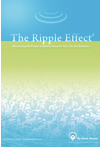Putting the RELATIONSHIP in Relationship Marketing Part 2

I am proud to have Marc Schwartz participate this week as our Guest Blogger. Marc, as many of you know, was the editor of my book and has been a client and good friend for the past several years. He is a master at RELATIONSHIP MARKETING and I felt it would be great to have share his thoughts on this important topic.
Marc is the owner of Think Write Communications and he can be reached at marc@think-write.net
A couple of years ago, I read Al Ries’s book, The Fall of Advertising and the Rise of PR, and thoroughly enjoyed it. Skimming it again the other day, one sentence in particular jumped out at me: “To be effective, advertising doesn’t need creativity. It needs credibility.”
The premise of the book is that advertising, through both overuse and misuse, has steadily declined in effectiveness over the years. It’s become background noise, electronic wallpaper, 4-color clutter. Bombarded by hundreds (perhaps thousands) of advertising messages each day, we instinctively, intuitively tune most of them out.
As a result, the advertising industry has redoubled its efforts to catch and hold our attention — even for 30 seconds! Ads are bigger, bolder, louder, more outlandish — and more creative — than ever before.
And that’s part of the problem. In the rush to make ads memorable, we’ve sacrificed real sales effectiveness, which depends on credibility and clarity. How many times do you remember a commercial — but not the product it’s supposed to be selling? How often do you doubt the truth of the claims you hear? If you’re like me, it’s more often than not.
Ries says the better alternative is PR, which inherently carries more weight and believability. Think about it this way — if you were offered the choice of a full-page ad in Newsweek or a full-page article written about your company, which would you choose? I’ve asked that question to a lot of people, and I have yet to find someone who takes the ad.
As consumers, we crave credibility. It’s trite but true — we want to do business with people we like and trust. As business owners, therefore, it’s incumbent on us to find ways to create that trust and likeability. And the Yellow Pages isn’t the answer.
Generating PR isn’t always easy for small and mid-sized businesses. There’s only so much air time or column inches to go around, and reporters are paid to find stories, not give handouts to companies desperate for exposure on the cheap. Those bland, stilted, company-centric press releases you’ve been churning out? Junk ‘em. If you want something that catches the eye of the press, create stories designed to appeal to their audience. Focus on timely issues, concerns, events, opportunities or trends. Find a credible way to deliver value to their readers, viewers or listeners, and if the press doesn’t beat a path to your door, they’ll at least return your calls.
Most companies tend to favor advertising to PR not because they doubt the latter’s effectiveness, but because the former is so much more controllable. Given the right resources, we can not only choose the form, message and media, but also when and where our target market will see it. Want a full-page ad in the Sunday New York Times? No problem. How about a Super Bowl ad? All you need is a few million dollars in your corporate checking account.
That’s the theory, anyway. The reality is somewhat different. Without mega-bucks to throw at advertising, our control slips away. We settle for what we can afford rather than what we really want, and we rationalize away the difference. Sure, a weekly full-page newspaper ad would be optimal, but a quarter-page ad once a month is almost as good, right? Right?
And just like that, we’re left dependent on a marketing mechanism that is neither particularly credible nor controllable.
OK, wise guy, you’re probably thinking, what do we do now? What’s needed is a hybrid strategy. Don’t abandon your advertising — but pick your spots carefully. Don’t give up on generating positive PR — but don’t depend on it occurring on your schedule, either.
There are a few tools that offer some the best of both worlds. Newsletters can be particularly effective in building credibility and brand image within a defined target market. You control the look, content and frequency (like advertising), but because there’s no overt sales pitch, it is also inherently more credible (like PR).
Some other good bang-for-your-buck tools to consider: special reports, articles or columns, dynamic web content, and books. Each can help establish you as a subject matter expert, reinforce relationships with current clients, and forge connections with prospects — or even the media.
Four key principles to keep in mind: credibility, consistency, frequency and value. More specifically: make every marketing piece credible; be consistent in tone, look and theme; use these tools regularly, on a set schedule; and deliver value with every communication.
Simple rules — and effective, if you apply them conscientiously.



No comments:
Post a Comment